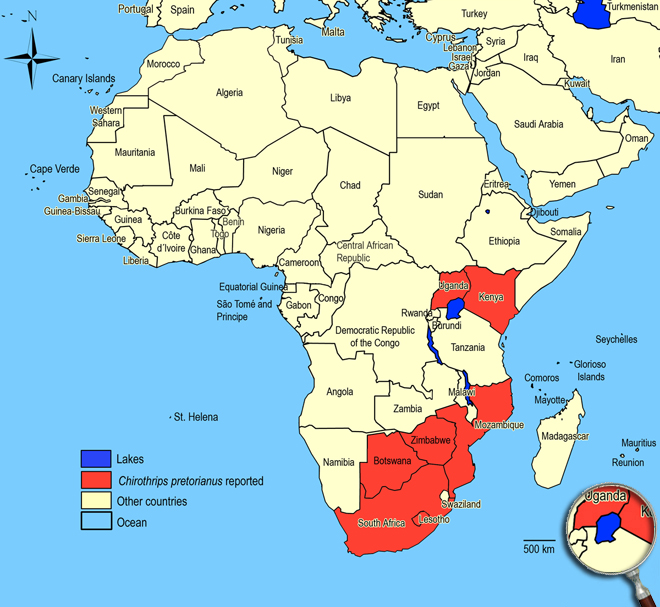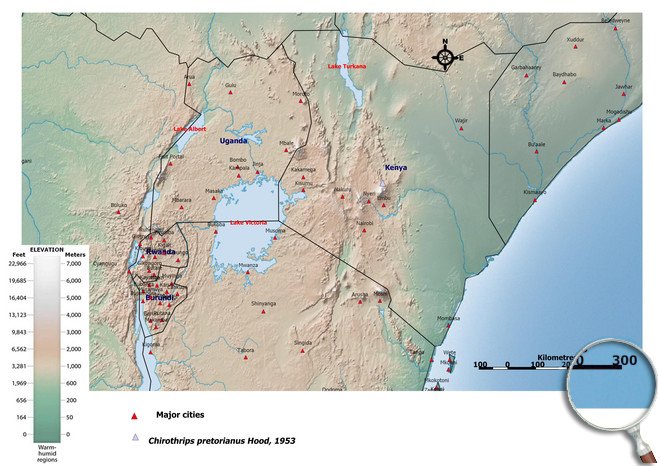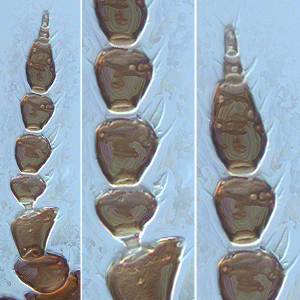Chirothrips pretorianus Hood, 1953
Thripinae, Thripidae, Terebrantia, Thysanoptera
Figures
Fig. 1: 8-segmented antenna, segments II-V (III and IV with simple sense cone), terminal segments V-VIII
Fig. 2: Head ventral with anterior tentorial arms
Fig. 3: Head dorsal with ocellar triangle
Fig. 4: Trapezoidal pronotum
Fig. 5: Prothoracic sternite region
Fig. 6: Meso- and metanotum
Fig. 7: Meso- and metasternum
Fig. 8: Pro,- meso- and metanotum, male (micropterous)
Fig. 9: Fore- and hind wing, fore wing distal region
Fig. 10: Sternites VI and VII
Fig. 11: Tergites VI-VIII
Fig. 12: Tergites VIII-XI
Introduction and recognition
Chirothrips pretorianus damages forage grasses and other Poaceae like sorghum and maize. Female macropterous; body, antennae and legs brown, tarsi paler; fore wings light brown and weakly shaded. Antennae 8-segmented; segment II asymmetric with prolonged external margin bearing a apical sens-area, III & IV with stout simple sense cone (Fig. 1). Head small and prolonged in front of eyes; with 3 pairs of ocellar setae, pair III anterolateral to fore ocellus (Fig. 2 and 3). Pronotum trapezoidal; with 2 pairs of elongate posteroangular setae (Fig. 4 and 5). Meso- and metafurca with well-developed lateral flanges, but without median spinula (Fig. 7). Metanotum irregularly reticulate; median pair of setae shorter than lateral pair and arise behind anterior margin; campaniform sensilla present (Fig. 6 and 8). Mid and hind tarsi 2-segmented; fore tibia not prolonged around fore tarsus. Fore wing pointed at apex; first vein with 2 or 3 setae on distal half; second vein with 5 or 6 setae (Fig. 9). Tergites with weak lines of sculpture medially; posterior margins with a series of independent small, triangular lobes; ovipositor moderately developed and bearing rows of teeth (Fig. 11 and 12). Sternites with 3 pairs of marginal setae, median pair on VII arise in front of margin; posterior margins without craspedum (Fig. 10).
Male micropterous (Fig. 8) and similar to female; sternites III-V with small circular glandular area.
Taxonomic identity
Species
Chirothrips pretorianus Hood, 1953
Taxonomic history
-
Common name
-
Present taxonomic position
Family: Thripidae Stephens, 1829
Subfamily: Thripinae (Stephens) Karny, 1921
Genus: Chirothrips Haliday, 1836
Genus description
The genus Chirothrips Haliday, 1836
Chirothrips currently includes about 45 to 50 species worldwide. Zur Strassen (1960) provided an identification key and catalogue of this genus for over 50 species, and Bhatti (1990) created six new genera for these species originally placed in the genus Chirothrips, and one of these, Arorathrips, is discussed in comparison to Chirothrips. Chirothrips appears to be a genus of Holarctic species, whereas Arorathrips is from the New World with a typical reduced mesothoracic endofurca. This genus has consistent characters that include small heads, short antennae with 8 segments, antennal segment II mostly expanded laterally (except in this key for Chirothrips guillarmodi), and a trapezoidal pronotum with 2 pairs of long posteroangular setae.
Species description
Typical key character states of
Chirothrips pretorianus
Coloration and body sculpture
Body color: mainly brown to dark brown
Surface of head, pronotum and fore legs: without obvious or with weakly reticulate sculpture
Antennae
Form of sense cones on antennal segments III and IV: emergent and simple on segments III and IV
Number of antennal segments: 8
Antennal segment I: without any setae on dorsal apical margin
Antennal segment II: without an exceptionally long seta at the inner apex
Antennal segment II shape: asymmetric with prolonged external margin bearing an apical sense area
Antennal segment III shape: symmetric
Length of antennal segment III and IV: antennal segment III similar in length to segment IV
Antennal segment IV and V: without a hyaline ring near the base
Antennal segment VI bears: not a remarkably dagger-shaped sensorium
Head
Distance between bases of ocellar setae III: greater than width of first ocellus
Head: distinctly prolonged in front of compound eyes
Ocellar setae I: present
Ocellar setae III: arising on anterior margin of, or in front of ocellar triangle
Ocelli: present
Length of postocular setae: not alternating short and long setae
Number of ocellar setae: 3
Prothorax
Number of pairs of long anteroangular setae: 0
Number of pairs of long posteroangular setae: 2
Number of pairs of elongate pronotal setae: 2
Pronotal blotch or internal apodeme: absent
Pronotum shape: trapezoidal
Pronotum posteromarginal/posteroangular setae: S2 longer than S3, not equal in length
Mesothorax
Mesosternal furca: without spinula
Metathorax
Metanotal campaniform sensilla: present
Metanotal median setae: S1 behind anterior margin
Metanotum with dominant sculptured triangle medially: absent
Metasternal furca: without spinula
Shape of metathoracic furca: transverse, V-shaped
Metanotal median setae length: shorter than lateral metanotal setae
Wings
Fore and hind wings: present, more than half as long as abdomen (macropterous)
Fringe cilia arising: from sockets
Fore wing veins: present
Fore- and hind wing surface: covered with microtrichia
Apex of fore wing: with prominent terminal setae
Fore wing anterior margin (costal vein): with setae and cilia but cilia longer than setae
Fore wing costal fringe cilia: arising at anterior margin of wing
Fore wing first vein: distinct from costal vein
Fore wing first vein setal row: incomplete, with setae not closely and uniformly spaced
Fore wing number of setae of second vein: 5-6
Fore wing second vein setal row: incomplete, with setae not closely and uniformly spaced
Fore wing shape: mainly parallel sided or margins run continuously towards each other
Fore wing surface: not reticulate
Fore wing first vein number of setae on distal half: 2-3
Fringe cilia on posterior margin near apex: distinctly wavy (undulated)
Length of fore wing costal setae at middle of wing: longer than half of median wing width
Shape of fore wing apex: with mainly posterior margin curved to join anterior margin
Wings: Fore wing extreme apex color: dark
Fore wings: uniformly light brown
Legs
Fore tibia: not prolonged around fore tarsus
Mid and hind tarsi: with two segments
Abdomen
Pleurotergites: not covered in microtrichia
Sternite II: with marginal setae but no discal setae
Craspedum on sternites II to V: absent
Sternites IV, V and VI: with marginal setae but no discal setae
Sternite VII median posteromarginal setae S1: arising in front of posterior margin
Sternite VII: with marginal setae but no discal setae
Surface of lateral thirds of abdominal tergites: without regular rows of fine microtrichia
Tergites II to VIII discal campaniform sensilla: situated in front of the discal setae S1 but somewhat farther apart than the setae
Tergites II to VII median setal pair: no more than 0.3 as long as median length of tergite
Craspedum on tergites IV to VI: present, with independent small, rounded triangular lobes
Tergites IV and V median setal pair: shorter than distance between their bases
Tergites V to VII: without ctenidia laterally, but sometimes with rows of microtrichia
Tergite VIII ctenidia: without paired ctenidia laterally, sometimes with irregular microtrichia
Tergite VIII posteromarginal comb of microtrichia: absent
Tergite X: not tubular, longitudinally incomplete
Setae on abdominal tergite X: all setae slender

Similar or related species
The species can be distinguished from other species of the genus Chirothrips by antennal segment II which is asymmetric with prolonged external margin bearing a apical sense area. Whereas Chirothrips manicatus as well as Chirothrips frontalis have a asymmetric antennal segment II with prolonged external margin bearing an exactly terminal small seta at tip, Chirothrips ah has a very slender and acute, slightly hook-shaped projection of the second antennal segment which bears a small sensorium at its apex, in Chirothrips guillarmodi antennal segment II is symmetric, and in Chirothrips meridionalis it is not strongly produced on outer margin, but drawn out into a sharply pointed angle. Compared to other species, in Chirothrips pretorianus the tergites have a craspedum with a series of independent small, triangular lobes (tergites of Chirothrips manicatus bearing a continuous craspedum with margin of weakly and rounded lobes; Chirothrips frontalis with a complete craspedum of unbroken border or flange at the posterior margin; Chirothrips ah and Chirothrips meridionalis with broadly rounded independent lobes fused at bases into continuous craspedum; Chirothrips guillarmodi with closely approximated but independent elongate lobes). Chirothrips pretorianus as well as Chirothrips frontalis with no sternal craspedum, whereas Chirothrips manicatus with sternites with entire posterior margin and a series of distinctive tubercles, Chirothrips ah and Chirothrips meridionalis with a craspedum of independent small pointed lobes, and Chirothrips guillarmodi with closely approximated but independent elongate lobes. Chirothrips pretorianus and most of Chirothrips species ocellar setae III arranged anterolateral to fore ocellus, and metanotal median setae are shorter than the lateral pair and arising behind anterior margin (except for Chirothrips ah with ocellar setae III on anterior margins of ocellar triangle and median metanotal setae which are distinctly longer than lateral metanotal setae and arising at anterior margin; Chirothrips guillarmodi and Chirothrips meridionalis with metanotal median setae arising at anterior margin). Moreover, the species have tergites II-VIII discal campaniform sensilla situated in front of the discal setae S1 but somewhat farther apart than the setae (as well as Chirothrips manicatus and Chirothrips frontalis). Chirothrips ah, Chirothrips guillarmodi and Chirothrips meridionalis have tergites II-VIII discal campaniform sensilla that placed between the discal setae S1 and S2 or posteriorly.
Species of the genus Chirothrips are similar to Arorathrips mexicanus, but Arorathrips mexicanus has a greatly reduced mesothoracic furca (furcal pits widely separated), fore tibia prolonged at apex around the external margin of the first fore tarsal segment, and tergites II-V with transverse row of small tubercles along antecostal ridge. Whereas all species of the genus Chirothrips have furcal pits on mesosternum fused in the middle line, fore tibia not prolonged around fore tarsal segment, and the sculpture of antecostal ridge on tergites II-V is more or less elongated. Compared to described species of Chirothrips, Arorathrips mexicanus has the sternite VII median posteromarginal setae arising at margin, whereas in species of Chirothrips these setae arise in front of posterior margin.
Biology
Life history
As with other thrips species the life cycle from egg to adult is dependent on temperature. The full cycle can take less than a week to over a month and adults may live for more than one month producing several generations in one year depending on seasonal weather (Lewis 1973).
Host plants
Poaceae: forage grasses, maize, sorghum.
Vector capacity
None identified, but possible mechanical distribution of phytopathogenic fungi and bacteria.
Damage and symptoms
All species in this genus Chirothrips breeding in grass flowers, sometimes their larvae and especially pupae are transported around the world within commercial grass seed.
Detection and control strategies
-
Additional notes
The precise host-plant on which this species breeds is not clear, but like all members of the genus Chirothrips the females lay eggs in the young flowers of certain grasses. Each larva apparently feeds within, and subsequently pupates within a single floret.
Biogeography
East, South and South West Africa. Botswana (Tuli Block area), Kenya, Lesotho (Mamathes), Mozambique (Umbeluzi - southwest of Maputo, Machava - near Maputo), South Africa (Gauteng: Pretoria - 4500 ft., Kameeldrif, Silverton, Pretoria Salt Pan; Limpopo: Ratomba - 21 miles east of Louis Trichardt 3150 ft., Pietersburg - 4100 ft., Mokopane - 4500 ft., Zebediela - 3400 ft., Modimolle - 4600 ft., Bela Bela, Satara - Kruger National Park; Mpumalanga: Nelspruit - 2350 ft., Komatipoort - Baberton District 1000 ft., Sabie - Pilgrim's Rest District 4500 ft., Lydenburg - 5000 ft., Loskop Dam, Bethal - 5600 ft.; North West: Buffelspoort - near Rustenburg 4000 ft., Rietspruit - Marico district 3500 ft.; Free State: Heilbron - 5100 ft., Bethlehem - 5300 ft., Bloemfontein - 4500 ft.; Western Cape: Longridge - north of Plettenberg Bay, Heidelberg - 300 ft., Ceres - in the Michelľs Pass 1000 ft., Worcester - 790 ft., Kleinmond, Smitswinkel Bay, Witteberge - 2100 m; Northern Cape: Kgalagadi Transfrontier National Park; Eastern Cape: Kidds Beach, Grahamstown - 1700 ft., Balfour - west of Seymour 2100 ft., Coldstream), Uganda, Kenya (Embu), Zimbabwe (Chegutu, Mutare, Birchenough Bridge - 1500 ft., Lutope Pools - on Bubye River).
African countries where Chirothrips pretorianus has been reported

Occurence of Chirothrips pretorianus in East Africa

Please click here for survey sites of all observed thrips species of Kenya, Tanzania and Uganda.
Click here for locations of Chirothrips pretorianus in parts of East Africa.

Bibliography
Bhatti JS (1990). On some genera related to Chirothrips (Insecta: Terebrantia: Thripidae). Zoology (Journal of Pure and Applied Zoology). 2 (4): 193-200
Hood JD (1953). Two new species of Chirothrips new to Africa (Thysanoptera, Thripidae). Revue de Zoologie et Botanique Africaines. 47 (1-2): 108-119
Lewis T (1973). Thrips: their biology, ecology and economic importance. Academic Press Inc., London Ltd., 349 pp
Minaei K & Mound LA (2010). Grass-flower thrips of the genus Chirothrips (Thysanoptera: Thripidae), with a key to species from Iran. Zootaxa. 2411: 33-43
Nakahara S & Footit RG (2012). Review of Chirothrips and related genera (Thysanoptera: Thripidae) of the Americas, with descriptions of one new genus and four new species. Zootaxa 3251: 1-29
zur Strassen R (1958). Studies in African Thysanoptera, 1. Journal of the Entomological Society of Southern Africa. 21 (2): 333-353
zur Strassen R (1959). Studies in African Thysanoptera, 2. Journal of the Entomological Society of Southern Africa. 22 (1): 174-198
zur Strassen R (1960). Key to and catalogue of the known species of Chirothrips Haliday, 1836 (Thysanoptera: Thripidae). Journal of the Entomological Society of Southern Africa. 23 (1): 144-176
zur Strassen R (1960). Catalogue of the known species of South African Thysanoptera. Journal of the Entomological Society of Southern Africa. 23 (2): 321-367
zur Strassen R (1967). Studies on the genus Chirothrips Haliday (Thysanoptera: Thripidae) with description of new species. Journal of the Entomological Society of Southern Africa. 29: 23-43
----
Web links
Mound´s Thysanoptera pages
Thysanoptera Checklist
ICIPE Thrips survey sites
UNI Halle & Thrips sites
Thrips of California
















